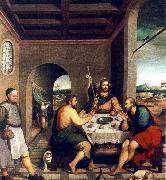|
|
|
|
|
BASSANO, Jacopo
|
|
Supper_at_Emmaus
|
|
|
|
|
|
|
|

|
|
Click to Enlarge
|
| BASSANO,_Jacopo
|
Supper at Emmaus
new21/BASSANO, Jacopo-925939.jpg
|
|
|
|
|
|
| 1538 Oil on canvas, 235 x 250 cm Sacristy, Parish Church, Cittadella Although undated, the painting is likely to go back to about 1538, a particularly felicitous period in Jacopo Bassano's art. Lorenzetti (1911) places it in the early part of the artist's stay in Bonifacio da Pitati's workshop and pointed out the obvious links with the latter's painting on the same theme, now to be seen in the Brera. There is a certain contrast between the solemn, hieratic figure of Christ and the rough and realistic close-up of the innkeeper on the one hand, and on the other, the little scene of the crouching dog being teased by the cat from a distance. The postures of the two disciples, the laboured perspective of the table, and some genre episodes were to recur in his later "Supper" version, now in the Borghese Gallery, Rome. The still-life in the centre of the work standing but against the linen tablecloth is a marvel of pictorial observation. A virtually lone harbinger of the main marks and elements of forthcoming Venetian painting (Tintoretto), Jacopo Bassano here sweeps the scene clear. In any case, light is the master here; it picks out the details and throws them into sharp outline. Artist: BASSANO, Jacopo Painting Title: Supper at Emmaus , 1551-1600 Painting Style: Italian , , religious |
|
|
Italian High Renaissance Painter, ca.1510-1592
Jacopo Bassano (also known as Jacopo da Ponte, c. 1515 - 13 February 1592) was an Italian painter who was born and died in Bassano del Grappa near Venice, from which he adopted the name.
His father Francesco Bassano the Elder was a "peasant artist" and Jacopo adopted some of his style as he created religious paintings with novel features including animals, farmhouses, and landscapes. He trained initially with his father, Francesco da Ponte the Elder, then in the studio of Bonifacio Veneziano. His mature style, however, followed the example of Titian. Having worked in Venice and other Italian towns, he established a workshop in Bassano with his four sons: Francesco the Younger (1549?C1592), Girolamo (1566?C1621), Giovanni Battista (1553?C1613), and Leandro (1557?C1622). They shared his style, and some works are difficult to attribute precisely.
|
|
|
|
|
|
|